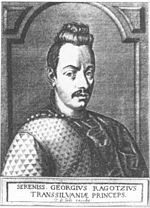How to Pronounce George II Rákóczi
#50
Most Popular
Boost
Jan 30, 1621 Sárospatak, Borsod Abaúj Zemplén County, Hungary Died on 07 Jun 1660 (aged 39)
Hungarian nobleman, Prince of Transylvania (1648-1660), the eldest son of George I and Zsuzsanna Lorántffy
Aquarius
